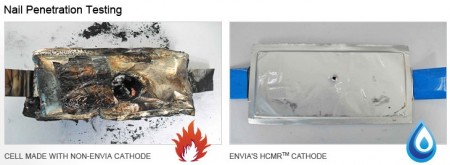Feb
28
The Best Battery So Far
February 28, 2012 | 2 Comments
Start-up called Envia Systems says it’s built a lithium-ion battery prototype at 400 Wh/kg. That, if the prototype can scale would be both a new world record, but a deep change in electric vehicle economics.
The world record looks secure for now, the battery prototype has third party tests confirming the energy density at the 400 watt hours per kilogram. In comparison, one of the currently manufactured at scale batteries is made by Panasonic rates at 245 Wh/Kg. That’s a battery model a person can buy.
Across from the new density rating are the projected costs. Envia’s Sujeet Kumar, Co-founder, President & CTO explains the demonstration prototype packaged as a 40 Ah pouch cell, in a new system could lower Li-ion cell costs to $180/kWh with further reductions to come.
A lot of people from the mainstream media to bloggers run numbers projecting a deep cut in electric vehicle prices. It’s not been easy to notice or find the specific number of charging cycles being talked about. There is graphic suggesting that by 300 cycles the battery is still at 91% capacity. This isn’t thousands of cycles, but hundreds. Lets all calm down. Envia still has work to do.
What has Envia way out in front are the electrodes. Envia calls the cathodes “high capacity Manganese rich” (HCMR), which is a lithium-rich layered-layered Li2MnO3·LiMO2 composite. The HCMR composite cathode material offers twice the specific capacity and lower cost compared to more conventional cathode materials.
Envia’s Kumar explains by engineering the cathode composition, structure, dopants, morphology and nano-coating, they’re able to precisely control and tune the specific capacity, cycle life, calendar life, rate capability and physical properties of the material to match any application. This suggests there can be trade offs among the specifications to get to specific applications. Retuned for cycles over 1000 the capacity is between 220 and 295 Wh/kg.
On the anode side Envia engineered at nano size with Si-C anodes at a resulting high capacity at 1530 mAh/g reversible capacity, a good rate capability running 95.5% capacity retention and good cycling performance – 90% capacity retention after 50 cycles in a half cell. On the anode side there doesn’t seem to be any easy quotes to reassure the careful observer. Again, this cycling performance isn’t a setup for mass marketing.
The company says it can see light now at the end of the tunnel for its working prototype based on lithium-ion chemistry and also said it will prove other scientists wrong who have said lithium-ion chemistry is limited in how inexpensive and energy dense it could be made to be.
Add to the electrodes technology the electrolyte is a proprietary compound. It’s very interesting to look at the effect of the nail gun test. Punch a nail through a conventional battery and the results are quite flammable spreading collateral damage, a nightmare potential in a serious collision or impact. The Envia website shows a proprietary pouch with a nail driven through that has, well, a hole in it – lacking the flame burned ripped apart imagery. Of course this is a proprietary test, but its quite an attractive property for a lithium-ion battery.
Congratulations are in order for getting to a rechargeable silicon anode based lithium-ion battery. This is no small feat. It seems the Envia team thinks it can drive to better results in the next few years. Keep in mind the requirements for cell phones and other small rechargeables, laptops and other mid-sized devices and electric vehicles have very different specifications and consumer expectations. Envia could get to some markets sooner than others.
But for electric vehicles a rebattery job at 1,000 cycles isn’t going to cut it or even come close. Your humble writer has looked at numerous studies over the years and today, subject to revision, is thinking electric vehicle batteries have to get to 300 Wh/kg charged over 3000 cycles at better than 90% capacity for under $130.
Lets say Envia gets to 400 W/kg and recharges 3000 times at $125. Then you will have a revolution.
Meanwhile – lets all stay calm. So, go get ‘em Envia!
Comments
2 Comments so far




1000 charges could be about 3 years before the battery has to be replaced, agreed, that is too short a life cycle.
However, if the cost to replace the battery pack is 3 years is $500.00 then all of a sudden this concern is not a deal breaker.
What is the expected replacement cost?
Maybe Envia can do it, maybe not. But I am getting the feeling that car batteries will be commercially feasible in 10 years.
For most Americans, this is wonderful news. Our cities will be cleaner, quieter and more prosperous.
Bring it on, baby, bring it on. I wish Envia every success.